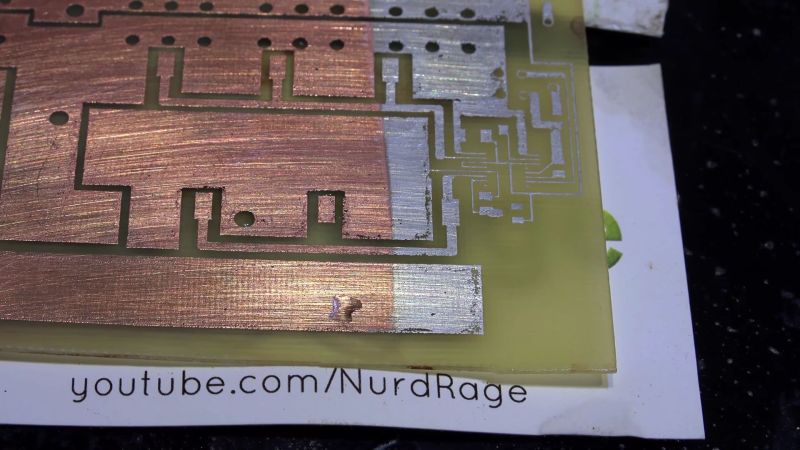Making your own printed circuit board at home often leads to a board which looks homemade. Exposed copper is one of the tell-tale signs. That may be your aesthetic and we won’t cramp your style, but exposed copper is harder to solder than tinned copper and it likes to oxidize over time. Tinning at home can bring you a step closer to having a full-featured board. In the video after the break, famed chemist [nurdrage] shows us how to make tinning solution at home in the video below the break.
There are only three ingredients to make the solution and you can probably find them all at a corner hardware store.
- Hydrochloric acid. Also known as muriatic acid.
- Solid lead-free solder with ≥ 95% tin
- Silver polish containing thiourea
Everything to pull this off is in the first three minutes of the video. [nurdrage] goes on to explain the chemistry behind this reaction. It doesn’t require electricity or heat but heat will speed up the reactions. With this kind of simplicity, there’s no reason to make untinned circuit boards in your kitchen anymore. If aesthetics are very important, home tinning yourself allows you to mask off certain regions and have exposed copper and tin on the same board.
[nurdrage] is no stranger to Hackaday, he even has an article here about making your own PCB etchants and a hotplate to kick your PCB production into high gear.
Thanks for the tip, [drnbutyllithium].
















Very interesting! What’s with the voice though? It sounds artificially lowered, and it’s more than a bit distracting.
Polyorchidism
Basically to avoid having this cause issues with his day job. Some managers get… twitchy… when their subordinates do anything publicly.
Yes, if anyone discovers my secret double life as a used Lexus salesman, I’m likewise screwed.
I used to use commercial tinning powder but it was a bit of a pain as made-up solution didn’t last long. It didn’t help much with solderability – a good clean and a coat with flux worked just as well.
PCB hot tinning is cheap and works much better leaving a good thick protective layer which is very easy to solder. Also is faster and less cumbersome than chemical tinning.
I’ve been using this method now for more than 30 years and the boads stll look almost like new.
Just flux the whole board with water soluble plumber’s sweating paste, grab some recycled eutectic solder (without any rosing) and use a wide chunky all copper pretinned squeegee tool heated to the right temperature, ~215ºC.
With this method can tin a double sided 100×160 board in less than 20 seconds with just a few passes. Don’t forget to wash thoroughly the PCB with plenty of warm water and soap to remove any trace of the solder paste.
Plumbers sweating paste is acidic and WILL cause corrosion.
I’ve been using this method now for more than 30 years and the boads stll look almost like new.
It will not.
Just so you know, *all* flux is acidic. And flux that is washed off can’t do anything.
“copper pretinned squeegee tool”
????
https://i.imgur.com/bLUTcOP.jpg
Sn63Pb37 no rosin core solder, or recycled solder blobs. 60/40 alloy also should work.
Water soluble plumber’s sweating solder paste (no ZnCl)
Pre-tinned copper tool (just a big chunk of copper with an edge tinned and a handle)
Also it’s easier to tin the boad before drilling (no burrs) but is not much of a trouble either.
It’s interesting and fun to watch, but just buy electroless tinning solution everyone.
You mean liquid Tin for MgChem?
It’s really expensive tho. I bought tinning powder to make around 0.5 liters of solution tops. For the same price I could’ve made it myself a larger batch. After all it is the same stuff.
Talking of quantity, in a few EU countries they now started to limit the sale of strong acid and such chemicals to single small bottles in shops.
That looks like a real, honest home made PCB. I see some of these articles and videos on PCB etching where the traces look shiny, smooth and completely untouched by acid and want to call BS!
What’s the best way to dispose of the mixture after use? Can something be added to “neutralise” it (if that concept makes sense here?)
Just add electrons to get your tin metal back as nice crystals ready for the next batch. https://www.youtube.com/watch?v=zziLOly2R8U Sodium bicarbonate should bind any chlorine it the solution that remains, as salt. However just zapping the solution then letting the tin redissolve may rejuvenate it if the HCl has not evaporated. However I’ve not had the opportunity to try this. Given that you can apply the tinning solution with a brush or cotton swab why would you really need to make up more than 20 ml for tinning a small PCB? It isn’t that toxic, the tin salt is a food additive, E512, so the tiny amount you have remaining can be diluted and dumped down a drain with the thiourea forming a sulfide with any metal salts it encounters, which may actually be a good thing as they are often insoluble.
Having made my share of homemade PCBs.. Honestly, just use a soldering iron and tin the board. It’s zen-like, it works perfectly and requires nothing except what you already have got.
What temperature is the hot plate at to cause the crystals to go back to clear liquid?